Wired, wireless models both have advantages, issues

Cameras have long been an essential part of school security systems, monitoring activities in both interior (hallways, classrooms, cafeterias) as well as exterior settings, such as athletic fields, playgrounds, and parking lots.
The development of Wi-Fi and wireless enabled cameras has made it possible to install them more easily in a wider range of places. However, both wired and wireless cameras each have their distinct set of advantages and challenges.
Here’s a comparative look at both systems.
Wired Security Cameras: Pros, Cons, and Differences
Wired security cameras are the traditional surveillance solutions that businesses, schools, and other institutions have been using for decades. While their tethered nature provides a reliable connection and makes them easy to power, this limits their flexibility and makes them more intensive to install and deploy.
Stable Connection: Because a wired security camera is plugged directly into the network, it generally maintains connectivity better than Wi-Fi and wireless options. While this leads to more cabling and wiring considerations, the data transmission and communications will be more consistent and stable.
Constant Power: Wired power, whether through a traditional electrical outlet or Power over Ethernet (PoE) cable, is as reliable as it gets. As long as the electrical grid and building infrastructure remain sound, the security camera will keep running.
Installation: Installing and deploying a wired security camera can be a challenge. Wires need to be run and logistical considerations mean that placement of each individual camera may be limited. In some cases, this factor can determine where a camera is deployed, even if the easiest location is not the best for optimum protection.
Wi-Fi/Wireless Security Cameras: Pros, Cons, and Differences
Wi-Fi security cameras offer more freedom than their wired counterparts. They don’t require a wired network plugin and instead operate over a wireless signal, much like a smart device in your home. This makes them easy to set up anywhere, but it can lead to some connectivity challenges depending upon the reliability of the network signal.
Ease of Installation: Wi-Fi security cameras can be deployed quickly and easily in almost any modern building. You don’t have to run new network cables behind walls or across drop ceilings and can simply deploy the device anywhere that has a power source nearby. This can make it especially easy to hang a single camera outside a building or near an entryway that otherwise has never been wired for connectivity.
Flexibility: As with deployment, Wi-Fi security cameras are also easy to move. If a surveillance strategy changes and the user wants to reconfigure the setup or add new cameras to the array, it’s as easy as mounting the device somewhere else.
Portability: As long as there is connectivity, the flexibility of Wi-Fi security cameras extends far beyond the building. If necessary, one can redeploy a device to a parking lot, other outdoor areas, or event venue at a moment’s notice with minimal effort.
Connectivity: Wired connectivity is generally more stable and reliable than signals sent over Wi-Fi. This can be mitigated by optimizing the placement of wireless access points. Well-maintained networks shouldn’t suffer disruptions often, but anything that isn’t plugged in will be more apt to lose connection or suffer interference. If a Wi-Fi camera array takes up excessive bandwidth, it could slow down existing IT infrastructure across a campus.
Cybersecurity: Wi-Fi security cameras with thoughtfully designed system architecture can be highly secure. However, they inherently have an extra point of vulnerability through Internet connectivity that wired cameras do not have. This won’t necessarily make a Wi-Fi surveillance camera system less secure than a wired option, but does require additional safeguards against internet-enabled threats.
Ultimately, the best camera for any application will be the one that fits your usage need and fulfills your requirements. A Wi-Fi or wireless security camera may be ideal for hard-to-wire deployments, whereas a wired security camera is better for commercial enterprises that require reliable continuous recording.
